We always need a way to relive the pressure of following the markets. You have to love a good headline that provides a lot of information in a few words. Of course, when every journalist has the same idea, it can go to an extreme like yesterday. Here is an example of an infectious narrative meme that can drive opinions. From my friend Marty Fridson, the high yield bond analyst guru:
Nikkei Asian Review
Pfizer vaccine hopes give Asia markets a shot in the arm
al.com
COVID vaccine news gives stock market a shot in the arm
Nikkei Asian Review
Pfizer vaccine hopes give Dow 800-point shot in the arm
The Guardian
BioNTech's Covid vaccine: a shot in the arm for Germany's Turkish community
Barron's
Pfizer Covid-19 Vaccine Might Work.
And that should give a shot in the arm to a health care niche that had ...
World First Foreign Currency Exchange
Pfizer gives sterling a shot in the arm
TechCrunch
5 VCs discuss the future of SaaS and software after Pfizer's vaccine ... news that one was coming was more than a shot in the arm — it was ...
NewsCenterMaine.com WCSH-WLBZ
The news, announced Monday morning, is a shot in the arm for public health ...
cbs.com
Watch CBS This Morning: Markets soar on Pfizer vaccine ...
Stock markets got a shot in the arm after promising news of a vaccine and election results were announced.
Office, apartment REITs get shot in the arm from vaccine news
TRD NATIONAL /
Financial Times
Opinion Lombard
Vaccine breakthrough is shot in the arm for Landsec
The Australian Financial Review
Vaccine news a shot in the arm for malls, offices
Telegraph.co.uk
UK growth to get shot in the arm from 'game-changing' vaccine







































